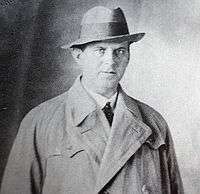Szilveszter Matuska
| Szilveszter Matuska | |
|---|---|
 | |
| Born |
January 29, 1892 Csantavér |
| Died | Unknown |
| Criminal penalty | death, commuted to life imprisonment |
| Motive | Possibly sexual gratification |
| Killings | |
| Date | September 30, 1931 |
| Location(s) | Berlin, Germany |
| Killed | 22 |
| Injured | 120+ |
| Weapons | Dynamite |
Date apprehended | 10 October 1931 |
Szilveszter Matuska (January 29, 1892 – disappeared c. 1945), was a Hungarian mass murderer and mechanical engineer who made two successful and at least two unsuccessful attempts to derail passenger trains in Hungary, Germany and Austria in 1930 and 1931. He was born in Csantavér (now Čantavir, Serbia).
Crimes
Matuska made at least two failed attempts to derail trains in Austria in December 1930 and January 1931.
Matuska's first successful crime was the derailment of the Berlin-Basel express train south of Berlin on August 8, 1931. Scores of people were injured, but there were no deaths. Because of the discovery of a defaced Nazi newspaper at the scene of the crime, among other things, the attack was believed to have been politically motivated. A bounty of 100,000 reichsmark was put on the perpetrator.
Matuska's second and more notorious successful crime was the derailment of the Vienna Express headed towards Vienna as it was crossing the Biatorbágy bridge near Budapest at 12.20am on 13 September 1931. 22 people died and 120 others were injured, 17 of them severely.
Matuska carried out his crime by blowing up a portion of the bridge, causing the engine and nine of the eleven coaches forming the train to plunge into a ravine 30 meters deep. Matuska was discovered at the scene of the crime but, having passed himself off as a surviving passenger, he was released. Investigators in the three countries were on his trail, however, and he was arrested in Vienna one month later, on 10 October 1931, whereupon he soon confessed.
Matuska was tried and convicted in Austria for two unsuccessful attempts. He was later extradited to Hungary on condition that he not be executed. He was found guilty of murder and sentenced to death, but the sentence was commuted to life imprisonment as agreed with Austria.
Matuska reportedly escaped from jail in Vác in 1944. According to some reports, he served as an explosives expert during the latter stages of World War II; he was never recaptured and his fate is unknown. Rumours have circulated that he appeared on the communist side in the Korean War, but there is no evidence to support this.
Matuska's motives remain unclear. His first attack was initially thought to have been politically motivated. At his trial, Matuska claimed to have been ordered to derail the express by God. Matuska has also been quoted as explaining his crimes by saying: "I wrecked trains because I like to see people die. I like to hear them scream." It was reported that he achieved orgasm while watching the trains he had sabotaged crash.
Popular culture
In 1990 Matuska became the subject of a song, Sylvestre Matuschka, by the band Lard.[1] A Hungarian/German TV film titled Viadukt was made in 1983 which was based on this case (English titled The Train Killer).[2] In 1993 Matuska became the subject of an art installation by Belgian artist Danny Devos. [3]
See also
- Symphorophilia — disaster fetishism
References
- ↑ http://www.alternativetentacles.com/product.php?product=25
- ↑ http://www.imdb.com/title/tt0083916/
- ↑ http://www.performan.org/works/sylvester-matuschka
External links
- Biographie: Sylvestre Matuschka (In French)
|